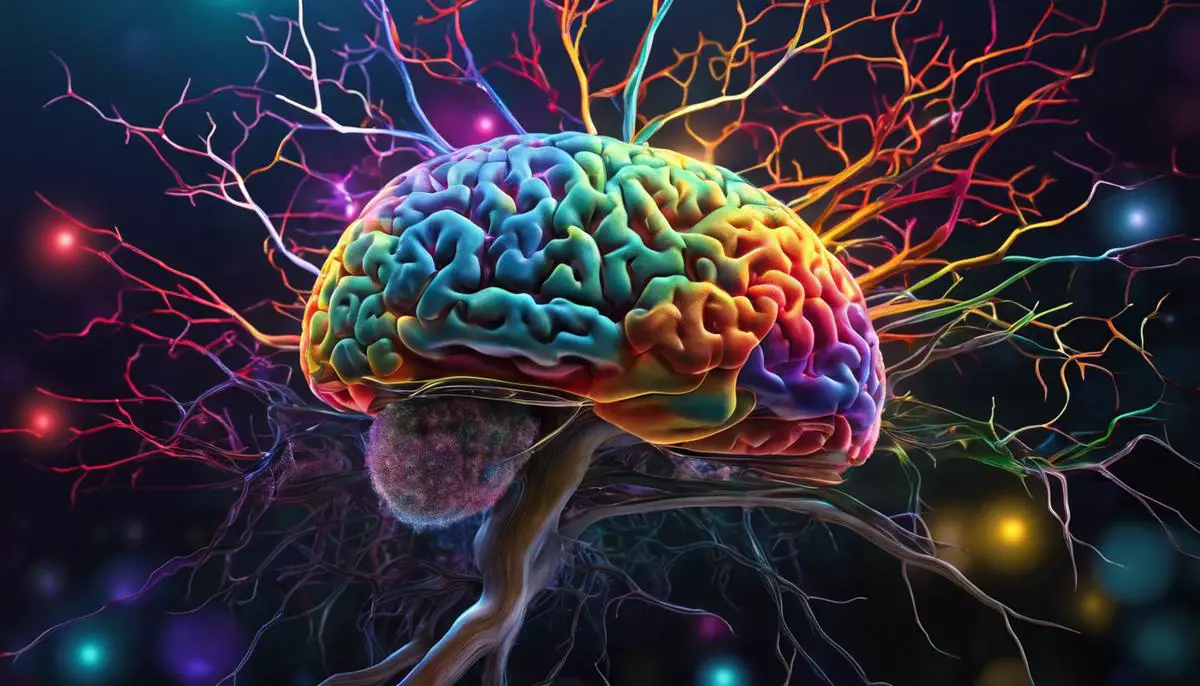Nightmares are a common part of human sleep, drastically varying in content and intensity, but generally bound by the thread of discomfort and fear. As predominantly unpleasant experiences, nightmares have been the subject of various scientific researches, striving to unravel their causes and implications. Particularly in adults, nightmares are recognized not merely as random sleep disruptions, but as complex phenomena deeply intertwined with several aspects of biological, mental, physical, and environmental circumstances. This essay delves into the diverse influences that can instigate nightmares in adults, presenting an exhaustive overview from neurobiological mechanisms to behavioral factors.
Biological and Mental Influences on Nightmares
Biological and Psychological Underpinnings of Adult Nightmares: An Analytical Foray
Ever since the Ancient Greeks penned their honorific epithets to Morpheus, the god of dreams, the enigma of human dreaming has perennially sought to be understood. The global pursuit of knowledge has not waned in this regard but has rather intensified, particularly in the dissection of nightmares – a phenomenon often shrouded in tumultuous fear and distress. An exploration into the biological and psychological underpinnings of adult nightmares opens an insightful discourse and demystifies an area often relegated to the enigmatic.
On the biological front, neuroimaging studies elucidate the somatic processes underlying nightmares. Rapid eye movement (REM) sleep, where most vivid dreams occur, sets the stage for this nocturnal drama. During REM sleep, our brain becomes intensely active, especially in regions like the amygdala and hippocampus, governing emotions and memories respectively. Neurotransmitters also play a key role. Serotonin, usually responsible for mood regulation, dips significantly during REM stages, resulting in elevated emotional responses and often giving nightmares their fearful quality.
Interestingly, our brains are evolutionary wired to respond to threats during REM sleep. The amygdala, a part of the brain responsible for generating fight-or-flight responses, is notably active during nightmares. This can be attributed to our ancient ancestors who needed to stay prepared for pervasive threats even while asleep, suggesting a survival mechanism encoded in our dreams.
On the psychological and mental side, nightmares have been linked to numerous psycho-emotional conditions. People suffering from anxiety and depression exhibit a higher incidence of nightmares, reflecting their troubled mental state. Post-traumatic Stress Disorder (PTSD) also poses a strong link, where terrifying dreams often mirror traumatic experiences, signifying the brain’s attempt to relive, process, or make sense of those events.
Cognitive processes greatly influence dream content as well. As per the continuity hypothesis of dreaming, it is suggested that dreams, including nightmares, are an extension of our waking consciousness. In other words, the thoughts, fears, and reticent emotions experienced in wakefulness often infiltrate our dream world, molding the narrative of our dreams and subsequently, nightmares. Football coach by day and chased by colossal footballs by night – the theme is often not too elusive to trace.
Nightmares, while decidedly uncomfortable, also provide a fascinating glimpse into the workings of the subconscious mind and its biological underpinnings. Unveiling the cloak of the night brings a better comprehension of our common human experiences, essential for devising effective therapeutic strategies and understanding ourselves more deeply. Despite the distress they cause, nightmares illustrate the depth, complexity, and indeed, the very human-ness of our brains in sleep’s ethereal realm.

Effects of Medication and Substance Abuse
Examining the Medicinal and Illicit Substance Impact on Nightmare Frequency and Intensity
The embedded influences of medicinal drugs and substance abuse on the human psyche has been a subject of in-depth study in the medical and psychological field. While the cultural and historical aspects of dreams and nightmares, as well as neurobiological processes during dream states, have been explored earlier, this article focuses on assessing how various substances directly affect the propensity and severity of nightmares.
ASOM (Altered States of Mind) fields of research have unearthed insights into how several pharmaceutical drugs induce altered dream states. Central to this exploration is the role of REM sleep—the stage of sleep where dreams, and by extension, nightmares occur. Particularly, medications that modify neuronal communications—Anti-depressant Selective Serotonin Reuptake Inhibitors (SSRIs) and Beta Blockers—have been correlated with increased nightmare occurence. Several SSRI drugs have side effects that include vivid dreaming and nightmares, likely a result of alteration in synaptic serotonin levels influencing neuronal communications. Beta-blockers, known for lowering blood pressure, can also intensify nightmares because of their function of blocking adrenaline binding to beta receptors, affecting neurological processes associated with dreams.
Venturing into the realm of illicit substances, narcotics play a significant role in shaping dream landscapes, often leading to heightened incidences of distressing nightmares. Opioid use, for instance, can cause terrifying nightmares in some users, often strengthening dream recall ability in the process. These substances tend to disrupt the normal sleep cycle, propelling an individual into prolonged REM sleep— the stage frequently associated with vivid, often horrific dreams.
Alcohol, a substance of choice worldwide, also has a profound effect on the sleep structure. Referred to as “REM rebound,” chronic alcohol ingestion suppresses REM sleep during periods of intoxication, then rebound to higher than normal REM sleep levels when intoxication wears off. This fluctuation often leads to vivid, distressing dreams or nightmares.
Additionally, the role of cannabis in dream manifestation has also been subject to extensive studies. Regular cannabis use tends to suppress users’ REM sleep. Upon cessation, REM rebound occurs, much like alcohol, often resulting in intense dreams or nightmares for the former user.
Substance withdrawal and nightmares are inextricably linked too. When an individual refrains from substances such as CNS depressants, opioids, or stimulants after prolonged use, withdrawal symptoms often include heightened occurrences of nightmares. This suggests an urgent need for more focused research on how medical and rehabilitation procedures could address such occurrences to ensure better patient compliance.
It’s therefore clear that the interaction of different substances with the brain’s complex neurochemistry significantly influences dream intensity and frequency. Our understanding of nightmares, and by extension, our overall sleep health, could greatly benefit from a deeper exploration of these interactions—an endeavor that undeniably requires unwavering dedication from researchers in the field.

Stress, Trauma and Life Events
The interplay of stressors, trauma, and life-changing experiences with our dream states, particularly nightmares, is a multifaceted issue that extends beyond the realms of psychological conditions and genetic predispositions. Notably, the manifestation of nightmares may, to some extent, also be attributed to the influence of medicinal drugs and substance misuse.
The current literature on Altered States of Mind (ASOM), for instance, provides compelling evidence that substances such as pharmaceutical drugs can induce altered dream states. Pharmaceutical drugs including selective serotonin reuptake inhibitors (SSRIs), frequently utilized in the treatment of depression, frequently result in an increased occurrence of nightmares. SSRIs, functioning to increase serotonin levels in the brain, have been noted to influence the brain’s rapid eye movement (REM) sleep structure, a period during which most dreaming occurs. It is during this REM sleep stage that the heightened nightmares typically surface.
Medicines termed as Beta Blockers, utilized for conditions such as high blood pressure and heart ailments, also feature in the discourse of nightmares. These medical agents function by blocking adrenaline binding to receptors, hence influencing neurological processes responsible for dreams. Their implementation has consequently been correlated with an escalated occurrence of dreams.
Substance misuse, including illicit substances such as narcotics, can also sculpt dream landscapes, eliciting distressing nightmares. Opioids, influential in disrupting the typical sleep cycle, have been identified with a direct link to elongated REM sleep and vivid dream manifestation.
In a similar vein, alcohol has significant effects on REM sleep as well, and its misuse often results in “REM rebound”, a period of intense, vivid dreaming or nightmares. This occurs on account of the suppression of REM sleep during intoxication, leading to a compensatory increase in REM sleep once the alcohol starts to wear off.
In contrast, regular use of cannabis generally suppresses REM sleep, which subsequently leads to the occurrence of intense dreams or nightmares once the individual ceases its use. This cessation prompts a “rebound effect” where dreams and nightmares may become even more vivid.
Notably, nightmares are also associated with substance withdrawal processes, particularly in relation to central nervous system depressants, opioids, and stimulants.
Given the complex nature of dreams and the scope for future studies, there is a pronounced need for further research. The key objective would be enhancing our understanding of the interaction dynamics, between substances, our brain’s neurochemical constructions, and their implications on dream intensity and frequency. This research could provide a basis for novel therapeutic strategies aimed at both reducing the distressing experiences of nightmares, and addressing the roots of substance misuse.

Sleep Disorders and Physical Health Conditions
Following this premise, we delve into the realm of sleep disorders and their potential impact on inducing nightmares. Sleep disorders manifest in many forms, with sleep apnea, insomnia, restless legs syndrome, and narcolepsy being some of the prevalent ones. The deleterious association between sleep disorders and nightmares can be nuanced but notable. The disturbed sleep architecture associated with these disorders can lead to fragmented, high arousal sleep, serving as ripe grounds for nightmares to occur.
Moreover, chronic pain and other physical health conditions can also lead to an increased frequency of nightmares. It has been noted that individuals suffering from ailments such as chronic back pain or fibromyalgia report a higher occurrence of intense nightmares. This increased frequency has been attributed to the distressed physical condition during sleep fostering a fearsome dream environment, thereby predisposing the individual to nightmares. However, the underlying mechanisms are not fully understood and further research is warranted in this regard.
Transitioning to lifestyle disorders, obesity is yet another health condition that can trigger nightmares. It has been concluded from various studies that the adverse effect of obesity on sleep – primarily via sleep apnea – can lead to vivid and stressful dreams. Addressing these health conditions and ameliorating lifestyle factors can potentially mitigate the occurrences of nightmares.
The impact of diet on dream experiences is another passionate area of research. Certain types of food intake, close to bedtime, which may elevate metabolism or body temperature, are often associated with vivid dream recall or nightmares. However, the effects are subjective and vary among individuals, necessitating personalized analyses to draw decisive conclusions.
Lastly, we focus on a burgeoning area of research – the genetic and neurobiological basis of nightmares. Certain genetic variations are shown to influence the REM sleep stage, specifically REM density, hinting towards the genetic predisposition to nightmares. This thriving field emphasizes the intricate interplay between genes, brain function during sleep, and occurrence of nightmarish episodes.
In conclusion, sleep disorders and other physical health conditions appear to be entwined with recurring nightmares, forming a twisted web of somatic and psychological distress. However, emerging interdisciplinary research, combining the understanding of neurobiology, genetics, psychology, and lifestyle habits, is bringing us a step closer to untying this web’s knots. As we step into the future, the hope is to develop personalized therapeutic strategies and robust prevention protocols based on the understanding of the complex nature of nightmares.

Lifestyle Factors and Environmental Triggers
The contribution of lifestyle factors in provoking nightmares has been further explored in recent studies. Of particular note is the influence of medicinal drugs and substance abuse.
Research related to Altered States of Mind (ASOM) suggests that specific pharmaceutical drugs could induce altered dream states. For instance, anti-depressant Selective Serotonin Reuptake Inhibitors (SSRIs) are associated with increased nightmare occurrence, and beta blockers have also been implicated due to their influence on adrenaline binding and neurological processes associated with dreams.
Moreover, the usage of illicit substances is another significant factor. Narcotics, for example, have been observed to shape dream landscapes and lead to distressing nightmares. Additionally, opioids disrupt the normal sleep cycle and have been associated with prolonged REM sleep and vivid dreams. Stimulants likewise can significantly contribute to nightmare episodes.
Alcohol, widely consumed around the globe, has a significant impact on REM sleep, often leading to the occurrence of “REM rebound” phenomena, which in turn may lead to vivid dreams or nightmares. A similar rebound effect may occur due to the suppression of REM sleep by regular cannabis use, which can result in intense dreams or nightmares upon cessation.
An intriguing area of study examines the link between substance withdrawal and nightmares, particularly in relation to CNS depressants, opioids and stimulants. These findings further emphasize the necessity for comprehensive research to understand the complex interaction between substances and brain neurochemistry in relation to dream intensity and frequency.
However, it is not just substance usage that shapes our dreams. Life and environmental stressors play a vital role too. The connection between stressors, trauma, life-changing experiences and dream states – particularly nightmares is taking precedence in current research.
Furthermore, sleep disorders significantly impact our dream narratives. Conditions such as sleep apnea, insomnia, restless legs syndrome, and narcolepsy can cause disturbed sleep resulting in fragmented, high arousal sleep, and thus nightmares. Coexisting conditions like chronic pain and other physical health issues could also lead to increased nightmare frequency. Emerging data suggest that obesity, through its adverse effects on sleep, may increase the possibility of nightmares.
Surprisingly, even our diet may impact our dreams, with specific types of food intake close to bedtime potentially leading to nightmares.
A fascinating addition to this mix is the exploration of the genetic and neurobiological basis of nightmares through advancing genomic science. Genetic variations influencing REM sleep and the interplay between genes, brain function, and nightmares is yet another complex puzzle for scientists to unravel.
The scope of the ongoing research clearly calls for an interdisciplinary approach to better understand this intriguing aspect of human cognition. The goal is to develop personalized therapeutic strategies and prevention protocols based on a comprehensive understanding of nightmares, thus advancing health and well-being in light of these often distressing experiences.

Understanding the nuanced causes of nightmares offers invaluable insight into better management and potential prevention of these unsettling episodes. As the exploration has revealed, nightmares are far more complex than mere unpleasant dreams – they are a mirror reflecting various underlying aspects from mental health conditions to lifestyle choices. By investigating these triggers, awareness can be fostered, paving the way for improved sleep quality and reduced frequency of distressing nightmares. Sleep, after all, is a fundamental pillar of our overall well-being, consequently making the effort to minimize nightmares an integral element of fostering optimal health.
